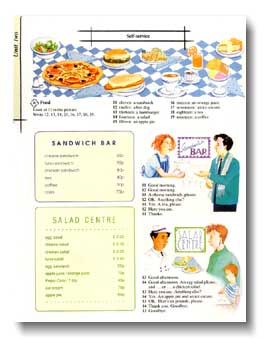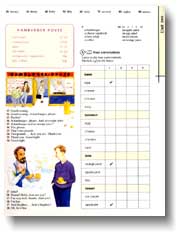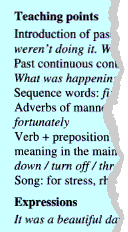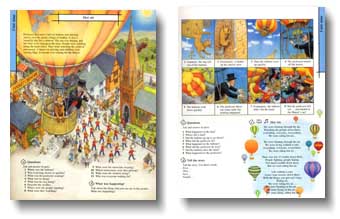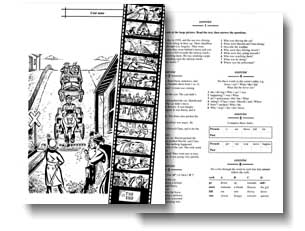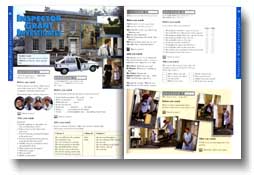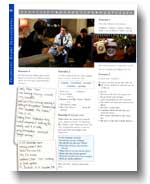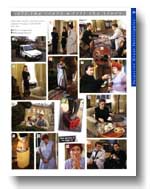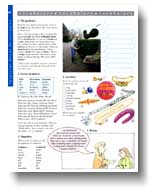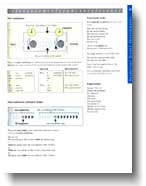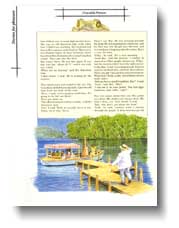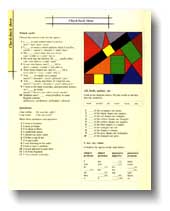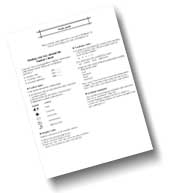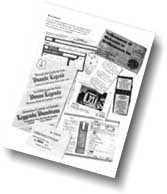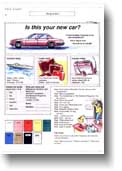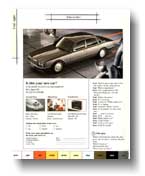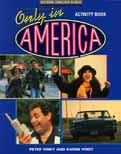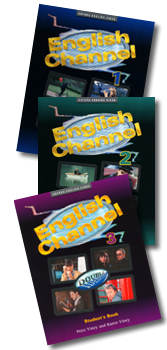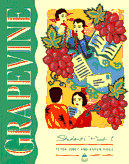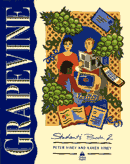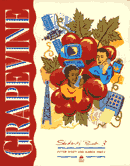
Go to the
Grapevine:
PRINT VERSION ( Download: 320k or 1 minute 30 seconds on a 28.8 modem)
Go back to Standard Version
by Peter Viney & Karen Viney
Real language, simple language
This is an example of an early unit from Grapevine One. Each unit consists of a double-page spread. Our aim here is to show students how much they can communicate with very simple language.
|
Unit 2, Self-service, left hand page The first section has several aims. • To make students aware that they already understand, or can guess a number of words connected to food. Few students will have trouble with 'sandwich', 'hamburger', 'hot dog' or 'coffee' • To familiarise them with numbers 11 to 20 in written and spoken form. |
Having matched the words and numbers, students listen to the dialogue. Note the minimal language:
A cheese sandwich, please?Anything else?
After each dialogue, they have a menu to use for paired practice. The menus AREN'T authentic. The sandwich bar menu has items at 40p / 50p / 60p / 70p / 80p and 90p- teaching the numbers is more important to us than the impact of a 'real' menu.
|
This is the second page of the unit. There are two more dialogues - on the tape, the gent with a briefcase has a very upper-class voice while asking for a hamburger - it's funny. There's a brief summary on a/an and the unit finishes with Listening for Specific information - all they have to do is to tick the appropriate boxes
|
A clear progression from simple to complex
We have a mission in Grapevine! For several years, we have felt that the classic skills of the course-designer were being eroded. As more and more attention had been paid to integrating skills, learner training and so on, we have found that courses have ignored the basic importance of a clear and logical structural syllabus. We found that important structural items (e.g. object pronouns) were thrown into longer units and were never actually 'taught.' There seemed to be a lack of awareness of sentence length and structure. Courses assumed that the use of infinitive and gerund patterns did not need teaching. They could just be thrown in.
|
Grapevine has a clear, carefully graded structural syllabus. We assume that learners will not be meeting native speakers nor having to "survive" in an English-speaking situation for at least the first level. We graded the first half of level one so as to blend the immediately useful (can, I'd like …, have got ) with units that presented thebasic building blocks thoroughly. Some courses equate the word 'grammar' with 'tense grammar' and rush headlong through the tenses. In Grapevine One, we present the verb to be, have got, I'd like … and can in the first twenty units, but we make sure that at the same time "non-tense" grammatical items are taught carefully - singular and plural, subject and object pronouns, possessive determiners, articles, mass and unit, possessive pronouns, number. The present continuous is used as a formula early on when it is functionally useful - describing people (She's wearing … ) and asking for directions (I'm looking for … ) |
|
The present continuous, going to future, present simple, past simple and future simple appear in the second half of the first level. We have often been asked why the present simple is taught later than most comparative textbooks, Try it! You'll find plenty to do in the early stages of Grapevine without 'racing through the tenses.' This solid foundation means that once students are working with more tense grammar, they will not be confused by other, simple problems. Each level has a clear Grammar Summaries section at the end of the book. In the Spanish edition this includes translation.
Integrated components
This example is from Grapevine Two. We're going to look at the teaching of the Past continuous tense through different components of the course (see Grammar summary above). The students have met the past continuous before (in Grapevine One) but as a fixed formula in describing people (She was wearing … ). We often introduce a formulaic expression before introducing the complete tense - I don't know well before the present simple, I'm looking for … well before the present continuous.
STUDENT BOOK
The tense is introduced in the Student Book unit 9:
|
|
|
The unit is designed as an initial tense teaching situation. There is a clear distinction between describing the simultaneous events in a large picture (using the past continuous) and describinng a sequence of events in a series of pictures (using the past simple). You can also see the use of 'passive vocabulary' - we mark words which help carry the context of a unit, but which are not worth remembering at this stage, with a 'P' in the Vocabulary Index at the back of the book.
The unit also contains a song, Hot Air, for stress, rhythm and catenation work.
TEACHER'S BOOK
The Teacher's Book gives detailed, step-by-step teaching notes face-to-face with the appropriate student page:
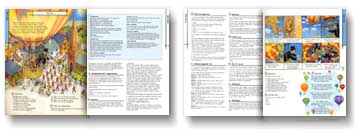
In the Times Educational Supplement review of Grapevine Two, the Teacher's Book was described as "a mini-teacher training course in its own right".
WORKBOOK
The Workbook for unit 9 has a parallel situation:
|
|
Note that the activities are designed to be easy to mark and easy to do. We had our ideas on Workbooks changed totally once our own children started coming home with language homework. We tried to avoid reptitive activities. Note the variety:
- Exercise 1 - comprehension questions
- Exercise 2 - matching and numbering. The written task is simple, but it requires thought.
- Exercise 3 - true / false. Again quick to do, but it shows deeper understanding.
- Exercise 4 - word order
- Exercise 5 - generating past tenses
- Exercise 6 - finding an inappropriate word. There are many vocabulary and sound exercises like this in the Workbook, which enable us to recycle words used earlier in the course.
THE VIDEO ACTIVITY BOOK
In unit 10, we need to see the tense used in a more meaningful way (for questioning about the past). Every 5th unit in the series has an optional video unit, which can be used to replace the Student Book unit, or in addition to the student Book unit. Unit 10 in the Student Book uses the same story with work on Listening.
The Video Activity Book gives you a chance of doing more with the material. There are pre-watching and post-watching activities for each section.
|
|
After finishing work on the video, you can go on to do more work in the classroom. Next comes an Exercise section:
|
|
|
Then there's Tell the Story:
|
|
This is followed by a Vocabulary section (in this case there is an interesting Learner training exercise on choosing which words are worth remembering) |
|
|
|
|
|
And finally each video has its own Reference section:
|
STUDENT BOOK - READING DEVELOPMENT
A major innovation in the series is the inclusion of four Reading for Pleasure sections in each level. These can be used in one of three ways:
- extensive reading for pleasure (our choice)
- intensive reading for review and consolidation (notes are given in the teacher's Book)
- intensive listening work for review (they are all recorded)
The early Reading for Pleasure sections utilise cartoon. By Grapevine Three the stories are getting long - some have as many words as the average short graded reader.
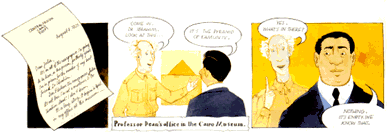
Part of 'The Secret of The Pyramid' from Grapevine One (after unit 25)
|
Part of 'Crocoldile Preston' from Grapevine One (after unit 35) |
By Grapevine Three there is necessarily more attention to reading and listening skills.
TESTING
|
There are two forms of testing in the series. There are CHECK-BACK units after every ten units in the course. This example is from Grapevine Two, and summarises units 21 to 30. |
There are also TESTS which are photocopiable and are incorporated in the Teacher's Book.
STUDY SKILLS
Learner skills appear throughout where relevant, with many references in specific Teacher's notes.However, each Workbook starts with a Study Guide section of four pages.
|
This is an example of the first Study Guide page from Grapevine 3 Workbook 1A (units 1 to 20) |
|
This is an example of another Study Guide page from Grapevine 3 Workbook 1A (units 1 to 20) |
VOCABULARY
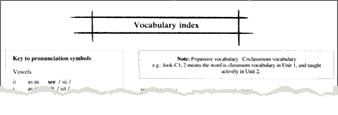
The vocabulary index has two features:
In levels two and three only, there are phonetic transcripts.
All vocabulary is divided into three areas: Active, Passive and Classroom (or instructional). A word may have several references. For example:
look- C1, 2
This means it is used as instructional language in unit 1, and taught actively (to be learnt) in unit 2.
Grapevine was the first book we did where we could track every vocabulary item throughout the series on computer, so ensuring that a word could be previewed as passive vocabulary, then later taught actively, repeated in Workbook units, Checkbacks and tests and recycled again in the stories. It was an enormous job, but one which should show in the classroom results.
Piloting Grapevine
Grapevine One was piloted as 'New English Course'. You may want to compare the pilot version with the final book:
New English Course, unit 8 page 2 next to Grapevine One unit 8 page 2
ONLY IN AMERICA
|
|
Only in America is the Main Street One & Two video. It shares a syllabus with Grapevine and can be used as additional video material in American English. |
NEW!!!
ENGLISH CHANNEL
|
|
English Channel shares a syllabus with Grapevine and can be used independently or in conjunction with it. |
